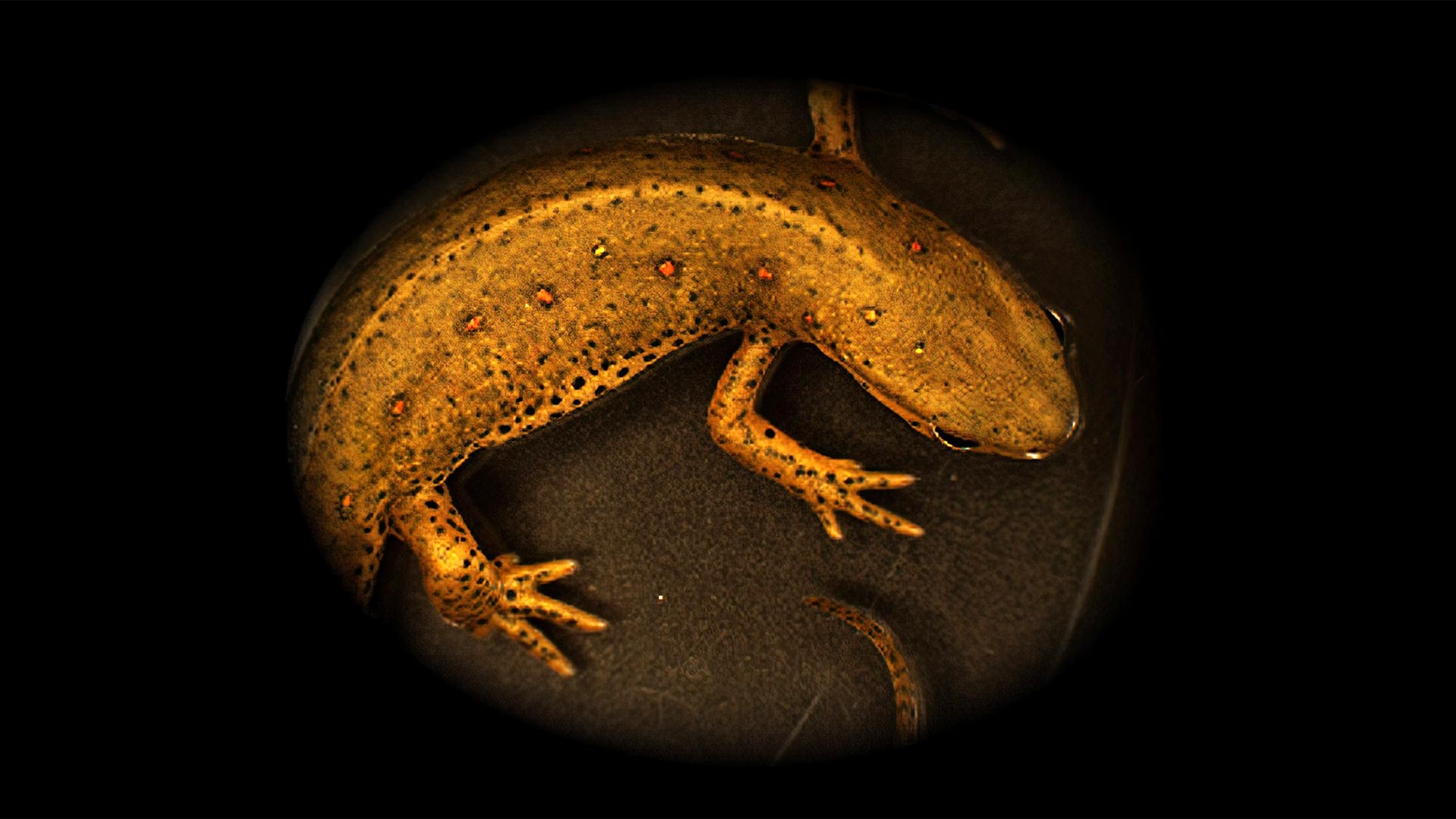
La especie de salamandra que estudió el equipo de Yun: un tritón de puntos rojos Notophthalmus viridescens. Mediante el estudio de las salamandras, que tienen notables capacidades regenerativas, los investigadores han descubierto que la presencia de células senescentes acelera el proceso de regeneración de las extremidades. Las células secretan factores que envían señales a las fibras musculares maduras para que se desdiferencien en células progenitoras musculares, mejorando la regeneración. Este hallazgo podría ayudar a los investigadores a comprender por qué los humanos tienen capacidades regenerativas limitadas y potencialmente desarrollar nuevos tratamientos para enfermedades relacionadas con la edad. Crédito: Massimina Yun
Los científicos muestran que las llamadas células senescentes, es decir, células que han dejado de dividirse permanentemente, aumentan la producción de nuevas células musculares para mejorar la regeneración de las extremidades perdidas en las salamandras.
Las células senescentes, vinculadas al envejecimiento y la enfermedad, también pueden tener propiedades regenerativas. Al estudiar las salamandras, los investigadores descubrieron que las células senescentes aceleran la regeneración de las extremidades al indicar a las fibras musculares que se desdiferencien, lo que podría conducir a nuevos tratamientos para enfermedades relacionadas con la edad.
Las células senescentes son células que han dejado de dividirse permanentemente en respuesta al estrés celular pero que no han muerto. A medida que los organismos envejecen, aumenta el número de células senescentes en el cuerpo. Esta acumulación se considera actualmente una de las características del envejecimiento y se ha relacionado con una variedad de enfermedades, incluido el cáncer. Sin embargo, la verdadera naturaleza de estas células puede ser más compleja y depende del contexto.
Un creciente cuerpo de evidencia sugiere que las células senescentes también pueden tener efectos beneficiosos, como curar heridas o prevenir la cicatrización de tejidos. “Hace unos años, nuestro grupo descubrió que las células senescentes estaban presentes en etapas clave de la regeneración de las extremidades de las salamandras. Curiosamente, otros grupos han encontrado posteriormente estas células en otros contextos regenerativos, incluidos los mamíferos. Por lo tanto, queríamos averiguar si estas células contribuyen de alguna manera a la regeneración en sí misma», explica la Dra. Maximina Yun, líder del grupo de investigación en el Centro de Terapias Regenerativas de Dresde (CRTD) y el Clúster de Excelencia Física de la Vida (PoL) en TU Dresde y en el Instituto Max Planck de[{» attribute=»»>Molecular Cell Biology and Genetics (MPI-CBG).
Senescent Cells Promote Regeneration
The researchers in Yun’s group study salamanders. These animals have unique regeneration abilities and are able to re-grow many organs of their bodies, including lost limbs. “Salamander limb regeneration is a fascinating process. In a matter of weeks, they re-grow a fully functional limb,” explains Dr. Yun.
To check if the presence of senescent cells influences the limb regeneration process, researchers in the Yun group found a way to modulate the number of senescent cells in the wound. The team observed that the presence of senescent cells enhanced the regeneration process.
“When more senescent cells were present in the wound, the animals developed a larger regeneration bud, or – as we call it – blastema. This is a collection of cells that are going to form all the needed tissues in the new limb. The larger the blastema, the more cells are there to regrow the limb and the quicker the regeneration process. The presence of senescent cells seemed to ‘fuel’ the regeneration process,” Dr. Yun says.
“Zombie” Signaling Promotes New Muscle Cells
Looking more closely at the blastema with and without the influence of the senescent cells, the Yun team uncovered a new mechanism that enhances the regeneration process and found that the presence of senescent cells increased the number of regenerating muscle cells. They showed that senescent cells secrete factors that stimulate nearby muscle tissue to take a developmental step back and produce new muscle.
“Our results show that senescent cells use cell-cell communication to influence the regeneration process. They secrete molecules that signal to mature muscle fibers to dedifferentiate into muscle progenitor cells. These cells can multiply themselves as well as differentiate into new muscle cells, thereby enhancing the regeneration process. This signaling appears to be an important part of promoting regeneration,” says Dr. Yun.
For now, the group focused on muscle, one of the most important tissues in the regenerating limb. However, the team is already investigating whether senescent cell signaling also contributes to the regeneration of other tissues.
Lessons From the Salamanders
Yun’s group is working with salamanders to study regeneration and aging processes. “Salamanders are one of the few animal species that seem to defy the natural aging process. They do not develop typical signs of aging and do not accumulate age-related diseases such as cancer. They also have extraordinary healing abilities,” says Dr. Yun. The animals can regenerate almost any organ in their body.
Studying salamanders is helping Dr. Yun and her colleagues at the CRTD understand the principles of the regeneration process and, in the long run, may help solve the puzzle of why humans have very limited regenerative abilities.
Reference: “Senescent cells enhance newt limb regeneration by promoting muscle dedifferentiation” by Hannah E. Walters, Konstantin E. Troyanovskiy, Alwin M. Graf and Maximina H. Yun, 6 April 2023, Aging Cell.
DOI: 10.1111/acel.13826

«Maven de internet exasperantemente humilde. Comunicadora. Fanático dedicado al tocino.»
También te puede interesar
-
Dormir bien el fin de semana puede reducir en una quinta parte el riesgo de sufrir enfermedades cardíacas: estudio | Cardiopatía
-
Una nueva investigación sobre la falla megathrust indica que el próximo gran terremoto puede ser inminente
-
Caso de Mpox reportado en la cárcel del condado de Las Vegas
-
SpaceX lanzará 21 satélites Starlink en el cohete Falcon 9 desde Cabo Cañaveral – Spaceflight Now
-
SpaceX restablece el lanzamiento pospuesto de Polaris Dawn, una misión espacial comercial récord

